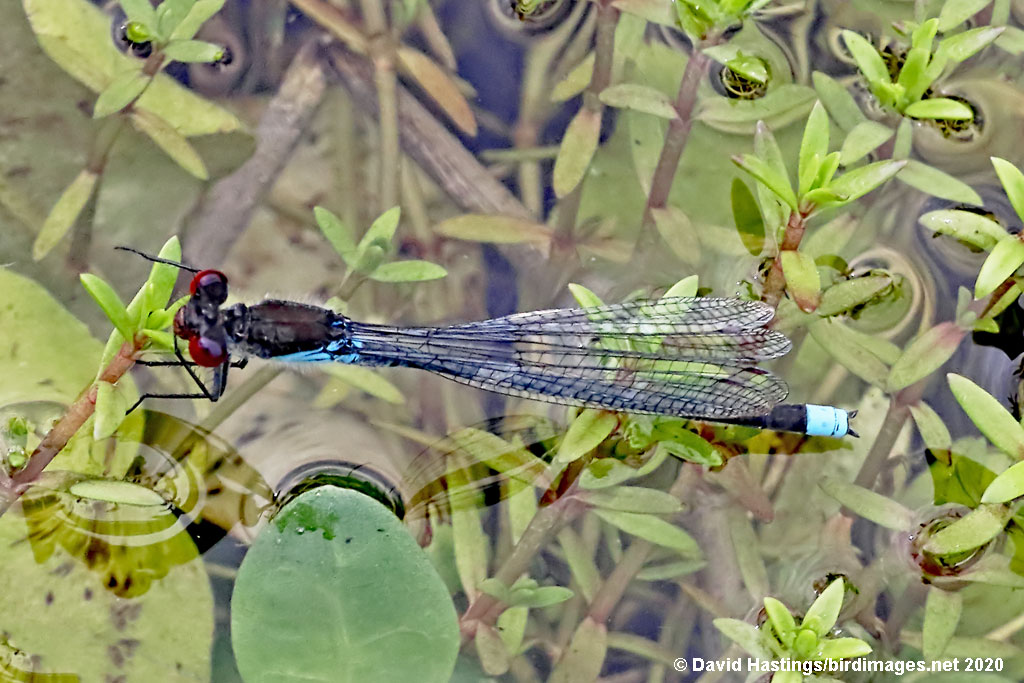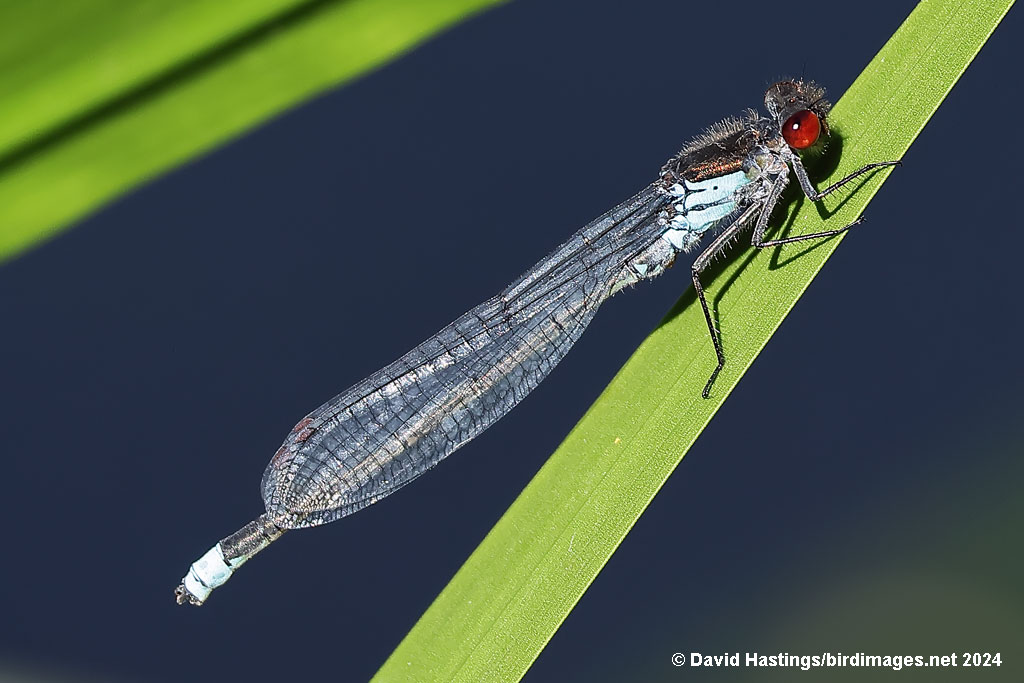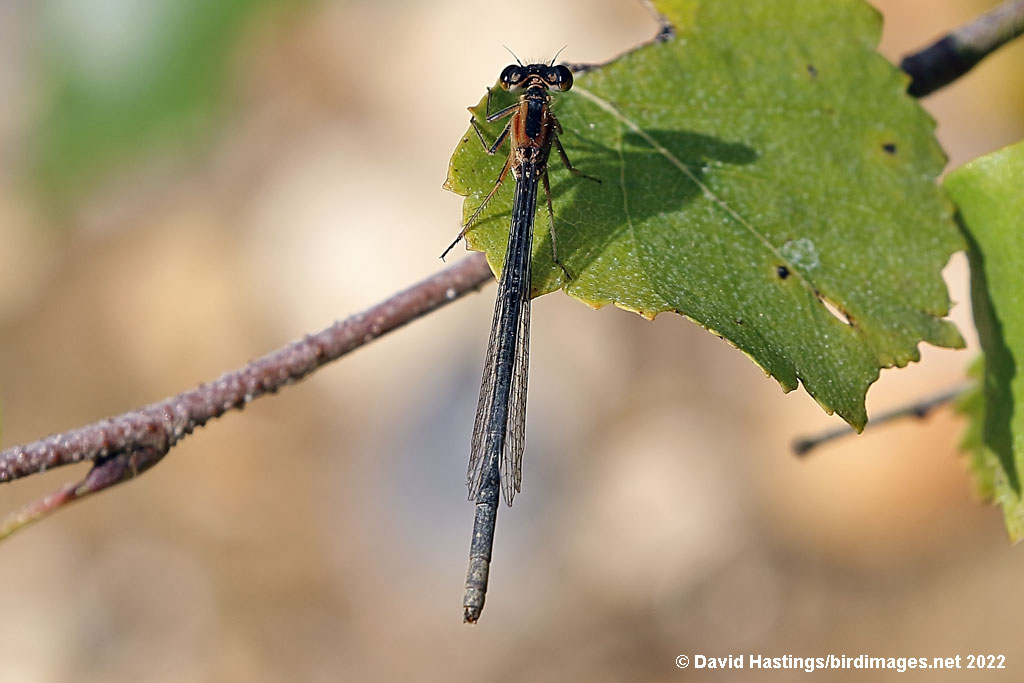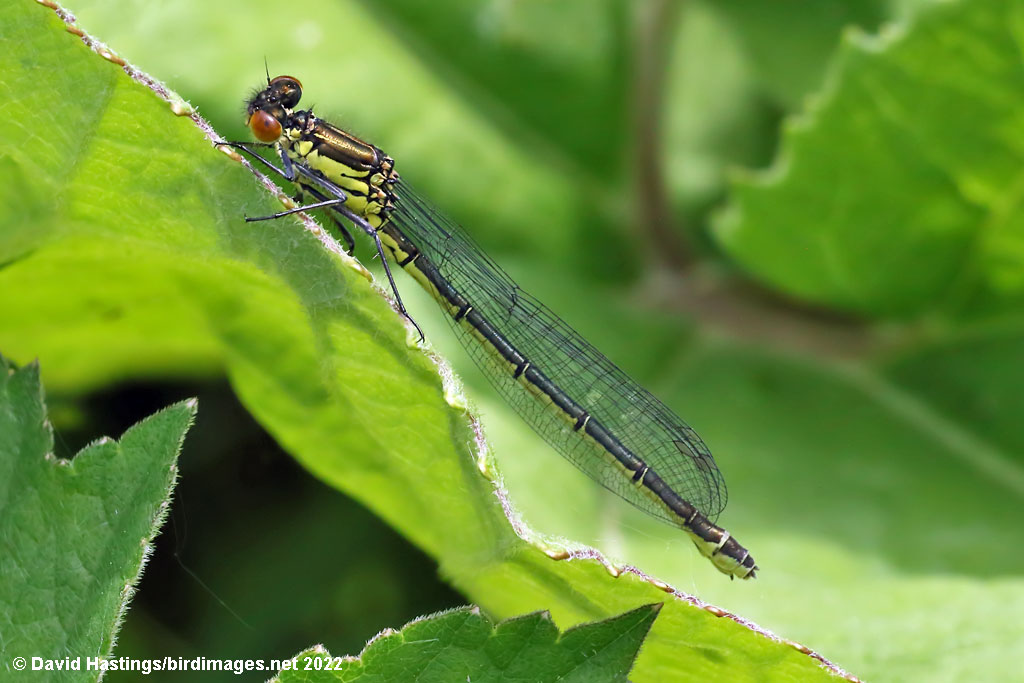 Red-eyed Damselfly (Erythromma najas). Male. Taken at Radley Lakes, Oxon., on August 18th 2020. Male. Taken at Radley Lakes, Oxon., on August 18th 2020. (© David Hastings) (1/400th sec at f13. Click image for larger version)  Red-eyed Damselfly (Erythromma najas). Male. Taken at Radley Lakes, Oxon., on August 16th 2024. Male. Taken at Radley Lakes, Oxon., on August 16th 2024. (© David Hastings) (1/800th sec at f9. Click image for larger version)  Red-eyed Damselfly (Erythromma najas). Female. Taken at Holden's Firs, Berks, on August 24th 2019. Female. Taken at Holden's Firs, Berks, on August 24th 2019. (© David Hastings) (1/400th sec at f11. Click image for larger version)  Red-eyed Damselfly (Erythromma najas). Female. Taken at Whelford Pools, Gloucs, on May 9th 2022. Female. Taken at Whelford Pools, Gloucs, on May 9th 2022. (© David Hastings) (1/1000th sec at f11. Click image for larger version) Description Wing span: 38 - 48 mm; body length: 30 - 36 mm A robust-looking damselfly with a dark greyish abdomen and a blue tail in the male. The eyes of the male are deep red and the thorax in both sexes is bronze black on top. The female has short, yellowish ante-humeral lines. This species is mainly found in the southern half of England. It is absent from Wales, Scotland and Ireland. Favoured breeding sites include larger ponds, lakes, canals, main drains and sluggish rivers. All feature floating vegetation such as water lilies. Eggs are laid while in tandem into stems and leaves of floating plants. The larvae live amongst vegetation and emerge after one, or more usually two years. Adults are on the wing from May to August, with a peak in June. Males are often found flying low over the water, or sitting on floating leaves, where they fight for strategically important positions near open water. A locally common species. Earliest UK sighting: 30th April ; Latest UK sighting: 21st September Sightings | 15-Aug-2025 | : | Radley Lakes, Oxon | (4) | | 25-Jul-2025 | : | Radley Lakes, Oxon | (5) | | 16-Jul-2025 | : | Greenham Common, Berks | (30+) | | 16-Jul-2025 | : | Mortimer, Berks | (1) | | 11-Jul-2025 | : | Rushy Common, Oxon | (1) | | 27-Jun-2025 | : | Radley Lakes, Oxon | (3) | | 18-Jun-2025 | : | Whelford Pools, Glos | (2) | | 30-May-2025 | : | Radley Lakes, Oxon | (16) |
| | 16-Aug-2024 | : | Rushy Common, Oxon | (1) | | 16-Aug-2024 | : | Radley Lakes, Oxon | (6) | | 11-Aug-2024 | : | Rushy Common, Oxon | (2) | | 09-Aug-2024 | : | Radley Lakes, Oxon | (6) | | 19-Jul-2024 | : | Radley Lakes, Oxon | (1) | | 26-Jun-2024 | : | Whelford Pools, Glos | (2) | | 13-Jun-2024 | : | Barnwell Country Park, Northants | (1) | | 17-May-2024 | : | Radley Lakes, Oxon | (1) |
| | 07-Sep-2023 | : | Folly Park, Faringdon, Oxon | (1) | | 16-Aug-2023 | : | Whelford Pools, Glos | (1) | | 23-Jun-2023 | : | Radley Lakes, Oxon | (6) | | 16-Jun-2023 | : | Whelford Pools, Glos | (6) | | 02-Jun-2023 | : | Radley Lakes, Oxon | (10) | | 27-May-2023 | : | Barnwell Country Park, Northants | (5) | | 26-May-2023 | : | Barnwell Country Park, Northants | (13) | | 24-May-2023 | : | Chimney Meadows, Oxon | (1) | | 16-May-2023 | : | Whelford Pools, Glos | (2) |
| | 04-Aug-2022 | : | Whelford Pools, Glos | (5) | | 10-Jun-2022 | : | Radley Lakes, Oxon | (9) | | 02-Jun-2022 | : | Chimney Meadows, Oxon | (9) | | 09-May-2022 | : | Whelford Pools, Glos | (10+) |
| | 12-Jul-2021 | : | Radley Lakes, Oxon | (5+) | | 08-Jul-2021 | : | Whelford Pools, Glos | (3) | | 25-Jun-2021 | : | Radley Lakes, Oxon | (20+) | | 13-Jun-2021 | : | Radley Lakes, Oxon | (20+) |
| | 21-Sep-2020 | : | Radley Lakes, Oxon | (2m,1f) | | 01-Sep-2020 | : | Radley Lakes, Oxon | (12+) | | 22-Aug-2020 | : | Radley Lakes, Oxon | (8+) | | 18-Aug-2020 | : | Radley Lakes, Oxon | (30+) | | 20-Jun-2020 | : | Radley Lakes, Oxon | (10+) | | 07-Jun-2020 | : | Farmoor Reservoir, Oxon | (4) | | 02-Jun-2020 | : | Culham, Oxon | (2) | | 30-May-2020 | : | Goring, Oxon | (34) | | 29-May-2020 | : | Radley Lakes, Oxon | (40+) | | 25-May-2020 | : | Radley Lakes, Oxon | (10+) |
| | 24-Aug-2019 | : | Greenham Common, Berks | (1) | | 24-Aug-2019 | : | Mortimer, Berks | (1) | | 11-Aug-2019 | : | Farmoor Reservoir, Oxon | (2) | | 11-Jul-2019 | : | Radley Lakes, Oxon | (10) | | 18-Jun-2019 | : | Barton Fields, Abingdon, Oxon | (2) | | 18-Jun-2019 | : | Radley Lakes, Oxon | (6+) | | 18-Jun-2019 | : | Abingdon, Oxon | (2) | | 09-Jun-2019 | : | Farmoor Reservoir, Oxon | (3) | | 02-Jun-2019 | : | Abingdon, Oxon | (7) | | 02-Jun-2019 | : | Radley Lakes, Oxon | (10) |
| | 25-Aug-2018 | : | Standlake Common, Oxon | (1f) | | 05-Aug-2018 | : | Radley Lakes, Oxon | (4) | | 17-Jul-2018 | : | Radley Lakes, Oxon | (14+) | | 10-Jul-2018 | : | Greenham Common, Berks | (6) | | 21-Jun-2018 | : | Whelford Pools, Glos | (10) | | 10-Jun-2018 | : | Barnwell Country Park, Northants | (10+) | | 08-Jun-2018 | : | Barnwell Country Park, Northants | (10+) | | 06-Jun-2018 | : | Otmoor, Oxon | (1) | | 02-Jun-2018 | : | Standlake Common, Oxon | (5) | | 02-Jun-2018 | : | Farmoor Reservoir, Oxon | (3) | | 18-May-2018 | : | Radley Lakes, Oxon | (1) |
| | 14-Jun-2017 | : | Whelford Pools, Glos | (2) | | 03-Jun-2017 | : | Abingdon, Oxon | (8) | | 30-May-2017 | : | Otmoor, Oxon | (2m) | | 21-May-2017 | : | Abingdon, Oxon | (1m) |
| | 16-Jul-2016 | : | Greenham Common, Berks | (10+) |
| | 12-Sep-2015 | : | Radley Lakes, Oxon | (2) | | 21-Jun-2015 | : | Otmoor, Oxon | (1) | | 13-Jun-2015 | : | Barton Fields, Abingdon, Oxon | (1) | | 07-Jun-2015 | : | Goring, Oxon | (6) | | 01-Jun-2015 | : | Otmoor, Oxon | (4) |
| | 16-Jun-2014 | : | Whelford Pools, Glos | (2) | | 25-May-2014 | : | Otmoor, Oxon | (4m) |
| | 06-Jul-2013 | : | Decoy Heath, Berks | (1) | | 06-Jul-2013 | : | Paices's Wood, Berks | (5+) | | 22-Jun-2013 | : | Otmoor, Oxon | (10+) | | 25-May-2013 | : | Otmoor, Oxon | (6 ten) |
| | 26-Aug-2012 | : | Greenham Common, Berks | (5m,1f) | | 18-Aug-2012 | : | Radley Lakes, Oxon | (40+) | | 09-Aug-2012 | : | Greenham Common, Berks | (10) | | 08-Aug-2012 | : | Radley Lakes, Oxon | (30+) | | 01-Jul-2012 | : | Otmoor, Oxon | (2m) | | 23-Jun-2012 | : | Otmoor, Oxon | (2) | | 17-Jun-2012 | : | Otmoor, Oxon | (10+) | | 16-Jun-2012 | : | Farmoor Reservoir, Oxon | (1m) | | 27-May-2012 | : | Radley Lakes, Oxon | (2) |
| | 04-Sep-2011 | : | Radley Lakes, Oxon | (20+) | | 14-Jul-2011 | : | Radley Lakes, Oxon | (4) | | 30-Apr-2011 | : | Otmoor, Oxon | (1) |
| | 25-Jun-2010 | : | The Brenne, Loire Valley, France | | | 22-Jun-2010 | : | Radley Lakes, Oxon | |
| | 31-May-2009 | : | Otmoor, Oxon | |
| |




